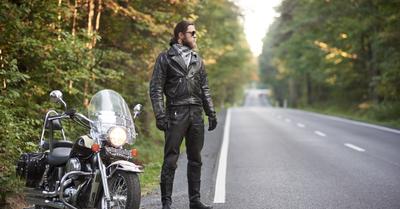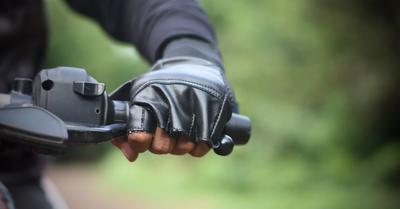What Is The True Gas Mileage For Harley-Davidsons?
Your Harley-Davidson motorcycle is going to get between 33 MPG and 60 MPG. And, yes, that’s quite a gap. It’s impossible to give a straight-up number without knowing the model, but that’s only half the story. After factoring in engine size, type of engine, and bike weight, there is still a number of other factors to consider like riding style, mods, tires, and whether you’re riding up a mountain or stuck in city traffic. Let’s discuss each one individually.
Overall Weight
It should seem obvious, but a heavier load means more power necessary to move said load from point A to point B. The bigger Harley cruisers weigh between 800 lbs and 930 lbs dry:
- 830 lbs: Harley-Davidson CVO Street Glide
- 870 lbs: Harley-Davidson Electra Glide Ultra Classic
- 880 lbs: Harley-Davidson Ultra Limited
- 930 lbs: Harley-Davidson CVO Road Glide Ultra
Now add the weight of your average non-dieting, skipped-the-gym-this-week, yes-I’ll-have-another-beer Harley biker and you’re adding another couple hundred pounds or three. So, your engine is burning extra fuel based on weight alone.
Highway vs. City
Obviously, a straight shot with no clutch engagement and no braking or accelerating means better fuel efficiency. Highway miles will add an average of 10 MPG to your trip making it a more efficient ride. City trips are full of stops and starts and a lot more fuel burned, so take that into account when adding up the miles you have left in your tank.
Riding Style
How you experience your Harley will be based on your individuality, and this is what makes estimating your MPG nearly impossible. No two people will have the same riding style; it often depends on your mood and personality. When the Detroit Lions play on Sunday (and lose, of course), I’ll leave the game in a different “riding style” than on a Tuesday after work. If your personality is riding your Harley hard revving up to the speed limit at the greatest amount of speed possible, you’ll incur fewer miles per gallon. But other bikers will Granny-ride their Harley’s and baby them getting the best possible MPGs. There actually is a sweet spot for gear-shifting that will garner better gas mileage (5th is around 41 MPH for me.) But this will depend on your cycle and engine. Just experiment and don’t waste gas with high revving between gears.
Extra Efficiency
While some mods are meant for power, sound, torque, and bling and are not for better gas mileage, some upgrades will actually improve MPG. So beware, when chopping your Harley and adding various extras, you will tend to lose fuel efficiency, but here are some mods that will actually help your wallet at the pump.
- Spark Plugs: changing these out more often and especially to Screamin’ Eagle “Spitfire” Plugs will improve MPG.
- Tire Pressure: Again, this will depend on your tire brand, so check the specs, but normally cold Dunlops on your Harley will often be 36 PSI on the front tire and 40 PSI on the back.
- Air Filters: A plethora of air filter kits abound for the Harley, and some aftermarket kits make some pretty bold claims about MPG, but these Screamin’ Eagle Air Filter Kits will improve the efficiency if switched out often.
- Synthetic Oil: A hot debate concerning synthetic oil lowering gas mileage is dividing bikers everywhere, but whether it does or doesn’t, it’s still a good idea. The synthetic oil will lower the engine temperature and protect engine components better and longer. And some people say, yes, it does lower the MPG.
How Do Harley-Davidsons Compare in Gas Mileage?
So how does your Harley-Davidson stack up to the competition? True, you didn’t buy it for fuel efficiency, but more for the sound, feel, comfort, and iconic cachet of the Harley name. Still, this is how it compares.
The five best motorcycles for fuel efficiency are the Suzuki V-Strom 650 at over 50 MPG, the
Yamaha SR 400 at over 60 MPG, the Kawasaki Versys-X 300 also over 60 MPG, the Honda Rebel 300 with a crazy 70 MPG, and the BMW G 310 GS also over 70 MPG. And, no, the Harleys don’t compare.
For a very comprehensive Harley-Davidson MPG chart, check out powersportsguide.com where you’ll see the little Street 500 doing well along with the 883 series, and, not surprisingly, the Road Kings and Electra Glides barely getting 38 miles out of a gallon.
What Are Harley-Davidson’s Gas Mileage Goals?
When it comes to improving gas mileage for the behemoth bikes that are Harley-Davidson, the company has five long-term strategic objectives. They are showing a heart for the planet and being sensitive to our changing climate conditions preventing as much of a carbon footprint as possible. The owners of Harley came out with a mission statement to “grow their business without growing their environmental impact.”
Governmental regulations are increasing for emission controls and sound pollution, and Harley-Davidson is trying to keep up with the culture shift that cares about generational environmental values. It seems counter-intuitive for a company that blends chrome, torque and raw power as its centerpiece to now compromise its brand for conservation, but you have to respect this new shift.
Not only have they gone electric with their new LiveWire OneTM motorcycle which has a range of 146/95 City/Combined miles and can fast-charge in 40 minutes almost flying off the track with a 3-second 0 - 60, but they have announced a fuel mileage goal of 50 miles to the gallon for every bike they produce by the year 2027. And by the way, the LiveWire is a pretty eye-catching blacked-out space-ship-looking motorcycle that doesn’t compromise the legendary Harley name.
They are already introducing game-changing design alterations to improve MPG through forced induction, direct injection, variable valve systems, friction-reducing components, and lighter materials. Hopefully, one day, this article will be woefully out of date as Harley-Davidson becomes a leader in fuel efficiency and global environmental responsibility.















